Alexandria Travel Guide
Where to Go and What to SeeAlexandria – Egypt’s Mediterranean Gem
Last Updated: 25 Feb 2023.
Like a miniature and more-manageable version of Cairo on the Mediterranean coast, Alexandria is sadly overlooked by many travellers to Egypt. The city has a wonderful mix of historic sites, crumbling old colonial buildings, a long seafront and, of course, the modern library of Alexandria, one of the largest libraries in the world. This guide contains everything you need to know to visit the city, including the best sights, where to eat, where to stay and how to get there.
Note: Some prices are in US dollars to ensure they stay current given the high rate of inflation in Egypt. Expect to pay approximately the equivalent amount in EGP at the current exchange rate.
Top Places to Visit in Alexandria
Alexandria is a historic city and its location on the coast is beautiful, so there are many things to see and do. These are my particular recommendations. However, if you have the time, just randomly strolling through the city is a wonderful way to experience it. Everywhere you go, you will find crumbling old buildings and the hustle and bustle of ordinary Egyptian life – which is anything but ordinary.
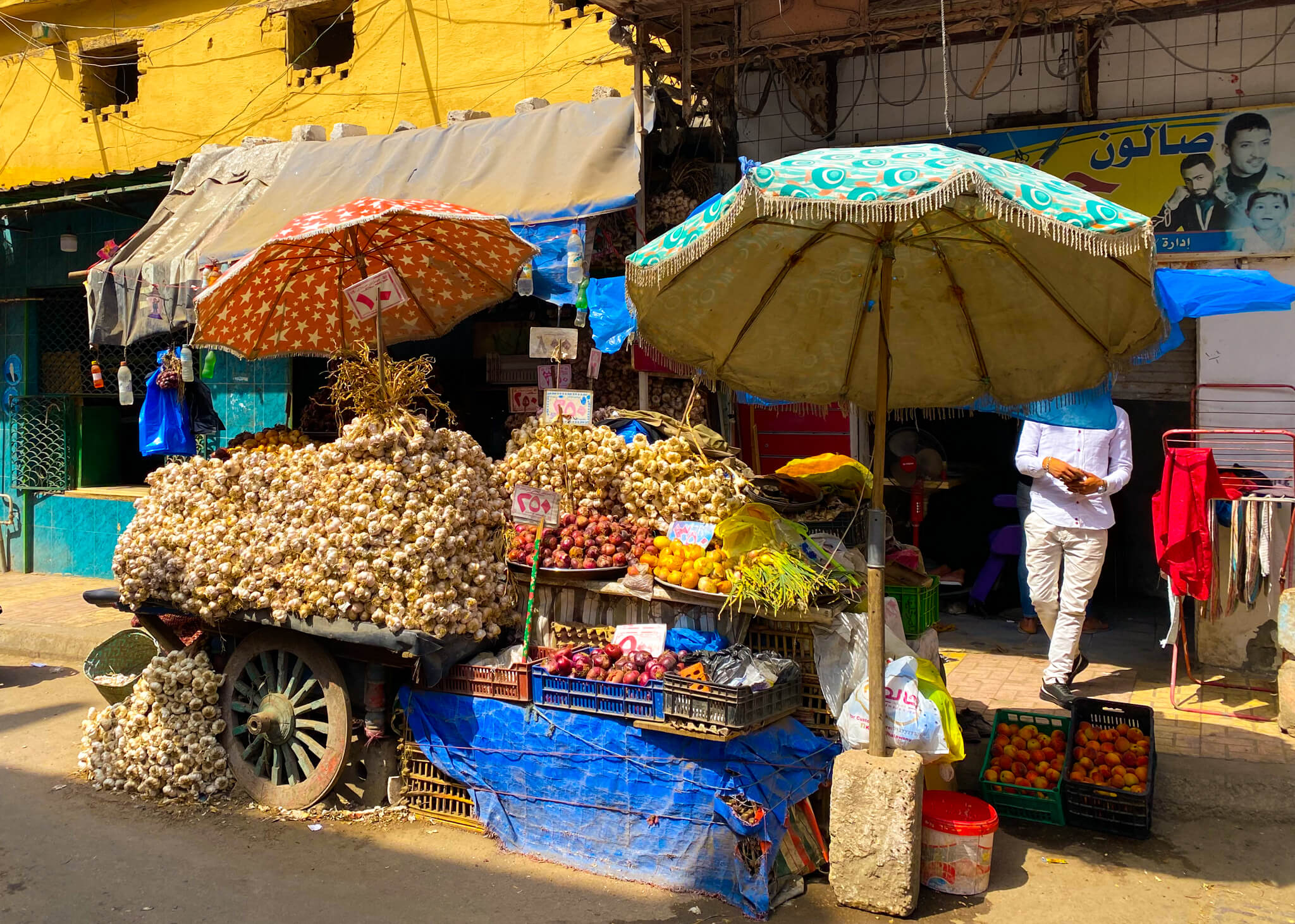
Alexandria’s markets are a mass of colours and intrigue.
Qaitbay Citadel and the Site of the Lighthouse of Alexandria
Qaitbay Citadel is a surprisingly modern looking citadel standing in a beautiful spot at the western end of the corniche. However, looks can be deceiving, and it was actually built by a sultan in the 15th century. The main building has three levels and a small but beautiful mosque that extends up from the ground floor to a beautiful dome built into the roof.
The rooftop is not open to the public. However, you can walk the city walls, which extend around all four sides of the grounds, offering beautiful views of the Mediterranean, the Eastern Harbour and the city itself.
The citadel was built right on the purported spot of the famous Lighthouse of Alexandria, one of the Seven Wonders of the Ancient World. Similarly to the Tower of Babel, the site of which I visited in Iraq, no one is quite sure of the original location of the lighthouse now. However, the most likely site is a location underneath one of the walls of the citadel. You can even visit some ancient foundations that have been excavated, and may or may not have been part of the original structure.
Entrance to Qaitbay citadel is EGP 70 (€2.17/$2.30) and it’s clearly marked on Google Maps. The walls of the citadel also house a maritime museum, if that’s what floats your boat.
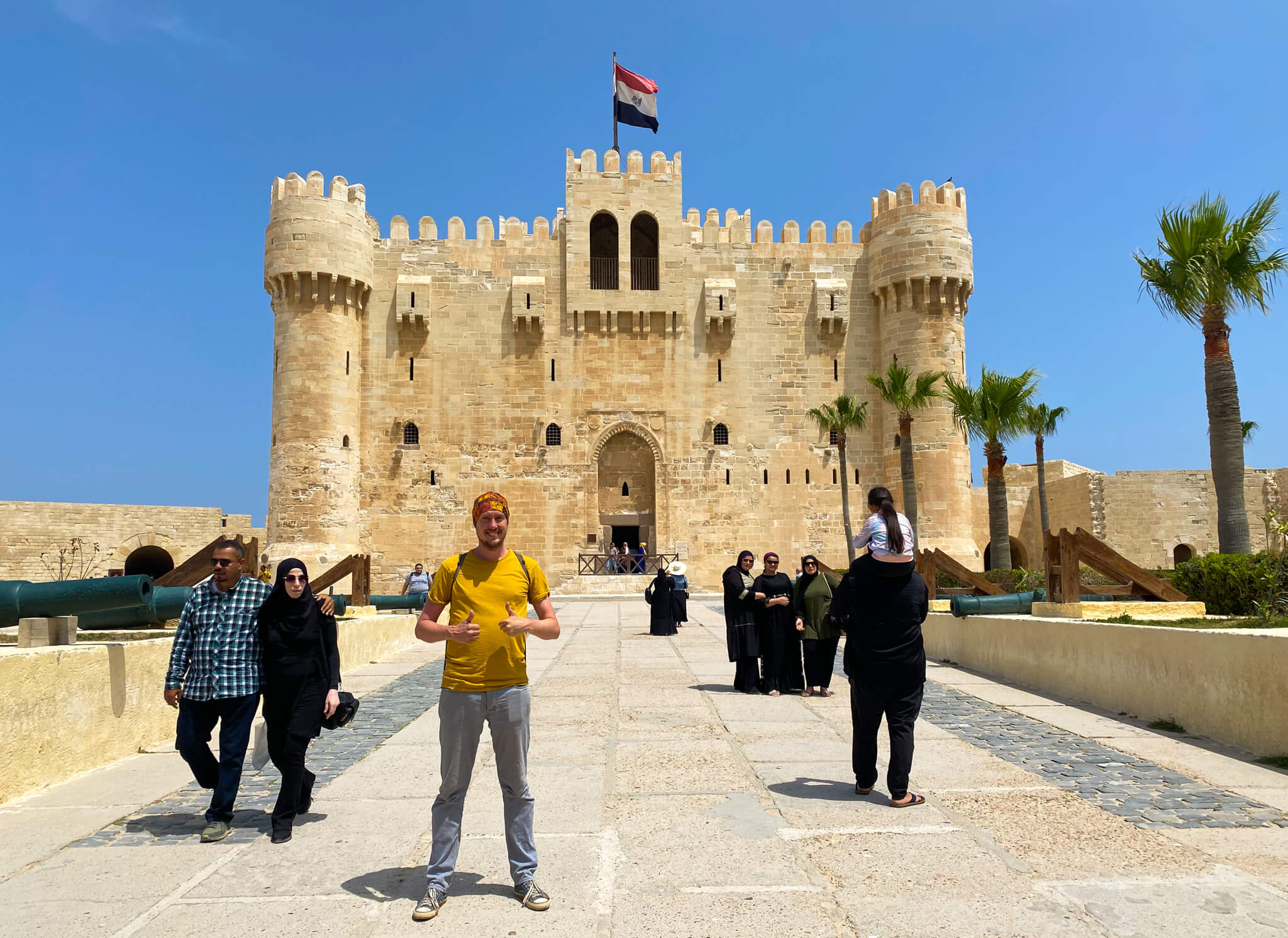
Qaitbay Citadel is a popular destination for locals as well as foreign tourists.
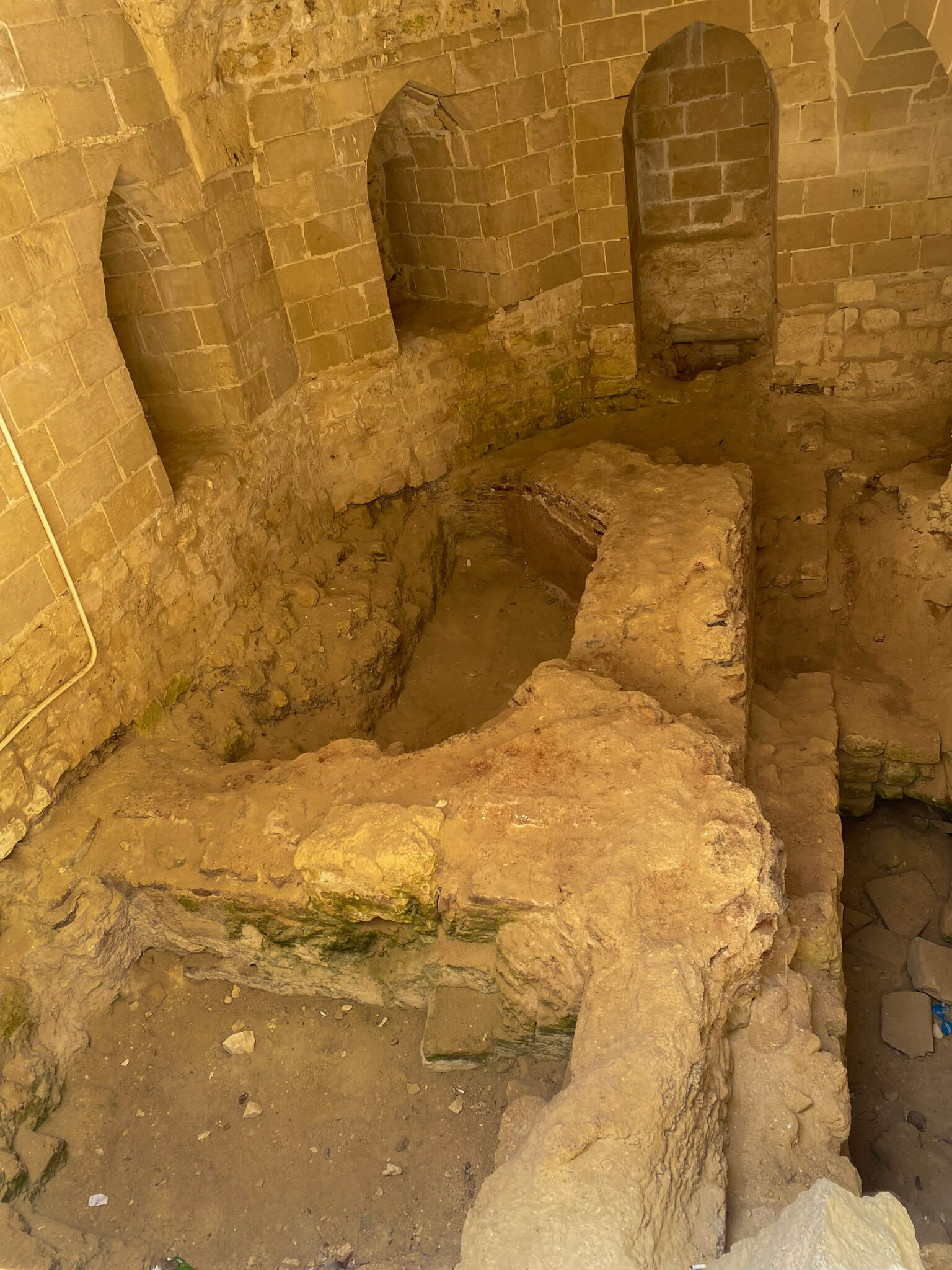
The foundations purported to be the remains of the Lighthouse of Alexandria, one of the seven wonders of the ancient world.
The Abu al-Abbas al-Mursi Mosque
The Abu al-Abbas al-Mursi Mosque is actually a group of three ancient Islamic buildings clustered together and is the most spectacular mosque complex in Alexandria. Unlike mosques in many countries, men and women can both enter the main chamber. The inside is beautifully decorated in a similar style to other Egyptian mosques, with rings of lanterns hanging from the ceiling. Foreigners are welcome and no one minded us taking a few photos while we were there (actually, some of the locals were doing the same).
Be respectful and quiet while inside the mosque. Shoes must be taken off before entering. There is no entrance fee, but if you leave your shoes in the boxes at the door, the man who watches them expects a tip (he asked for EGP 1, about €0.03/$0.03). The mosque opens around midday until late in the evening, when it’s lit up beautifully. It’s located near the western end of the corniche and clearly marked on Google Maps.
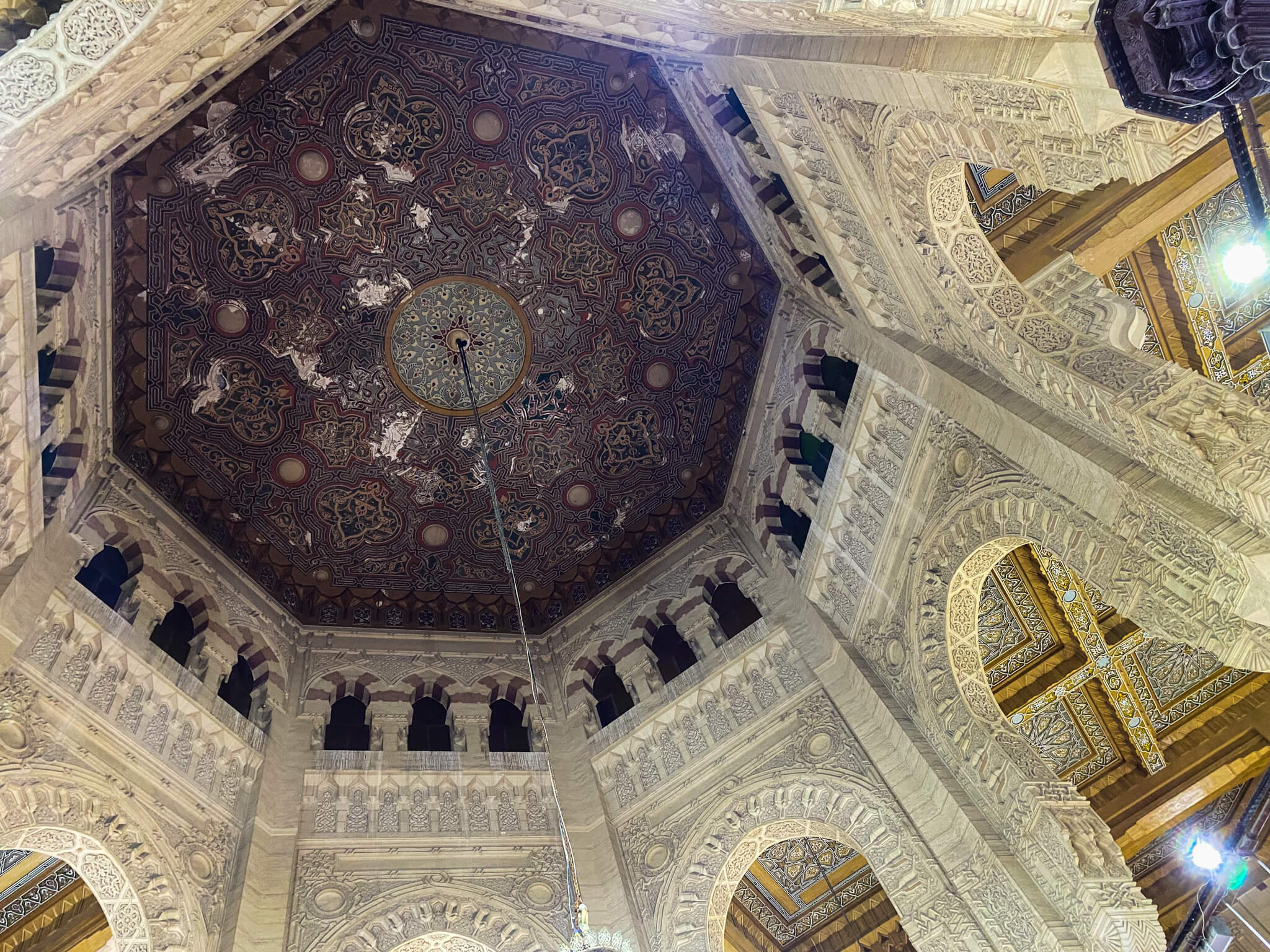
The main dome of the Abu al-Abbas al-Mursi mosque is incredibly ornate.
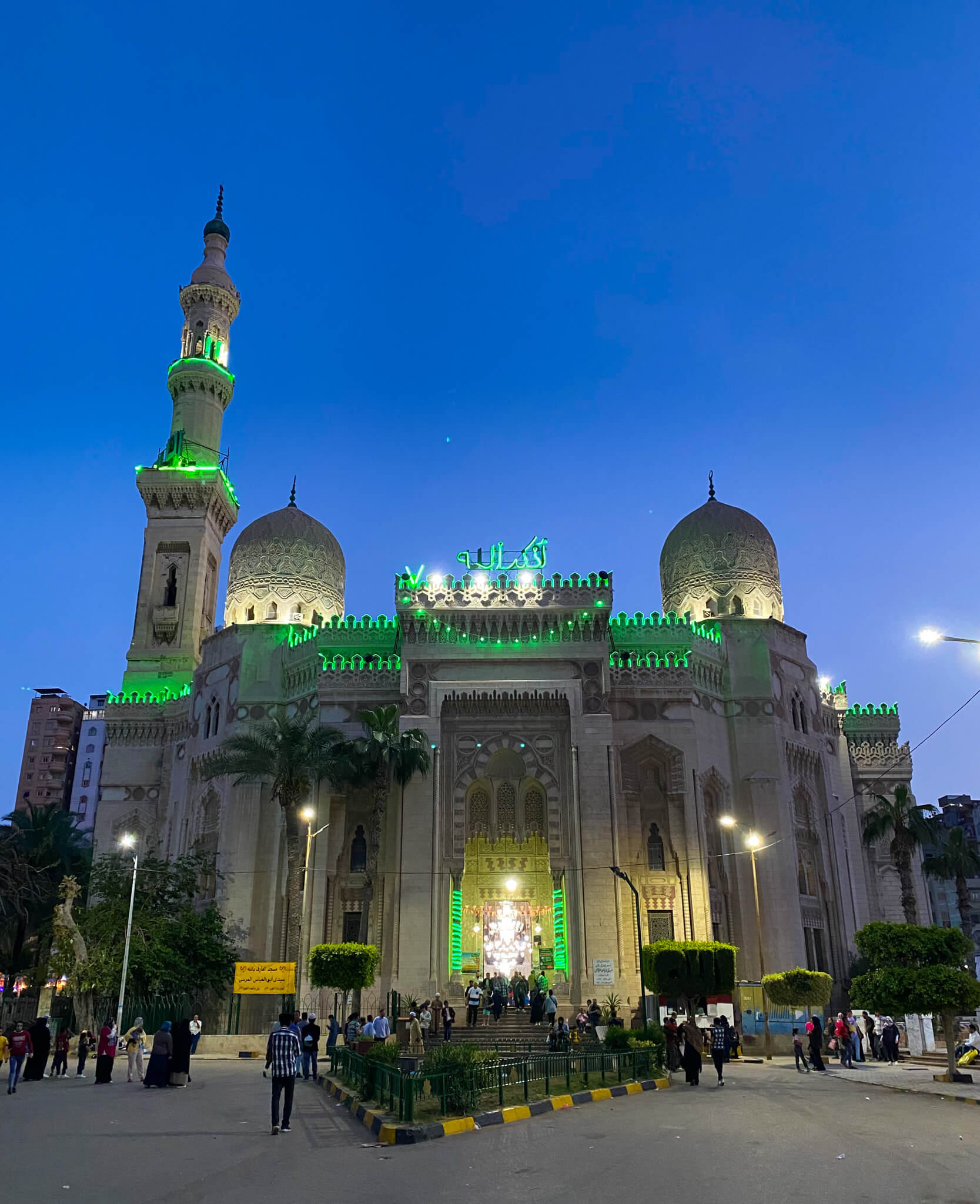
The Abu al-Abbas al-Mursi mosque is at least as beautiful at night as it is during the day.
The Serapeum of Alexandria and Pompey’s Pillar
Pompay’s Pillar is an archaeological site containing the towering namesake pillar and a collection of smaller statues, including a pair of sphinxes. Funnily enough, the pillar has nothing to do with Pompey whatsoever. It was built in honour of Roman emperor Diocletian between 298 and 302 AD. However, the inscription was badly damaged and a Greek word on it was mistaken for a dedication to a first-century BC general called Pompey. The name has stuck ever since.
The pillar itself is nothing special, but the juxtaposition between the ancient artefacts and the surrounding modern apartment blocks is an interesting sight. It’s worth exploring the site thoroughly, as there’s also the remains of the Serapeum of Alexandria, an ancient Greek temple that contained an offshoot of the ancient Library of Alexandria. A couple of tunnels of the underground section of this structure have been excavated and are open for viewing.
Entrance costs EGP 80 (€2.50/$2.60) and the location is clearly marked on Google Maps. Inside the site, from Pompey’s Pillar, head towards the back corner, away from the main entrance, to find the Serapeum.
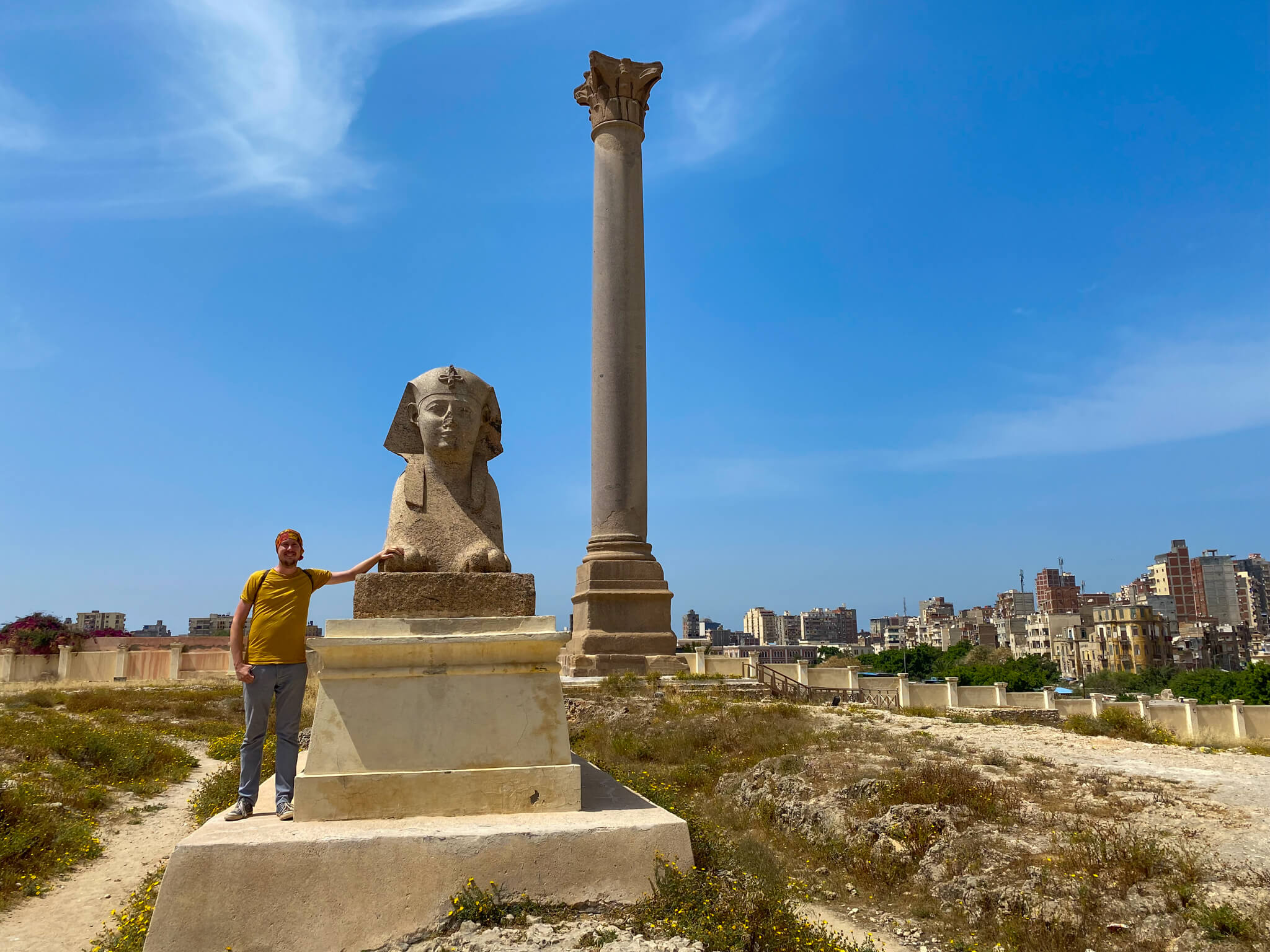
The juxtaposition between the ancient Pompey’s Pillar and the apartment blocks in the background is striking.
The Catacombs of Kom el Shoqafa
For me, the Catacombs of Kom el Shoqafa was the most impressive of all the sights I visited in Alexandria. They consist of an extensive labyrinth of underground passages spread over three levels. The mishmash of different architectural styles reflect the different civilizations that buried their dead there. Influences include Pharaonic funerary cult, including paintings similar to those widely seen in Luxor, Hellenistic and early Imperial Roman. Some of the carved reliefs are particularly impressive. There are also several tombs above ground, which are worth a quick look.
Entrance costs EGP 80 (€2.50/$2.60) and the location is clearly marked on Google Maps.

The architecture of the catacombs is exquisite.
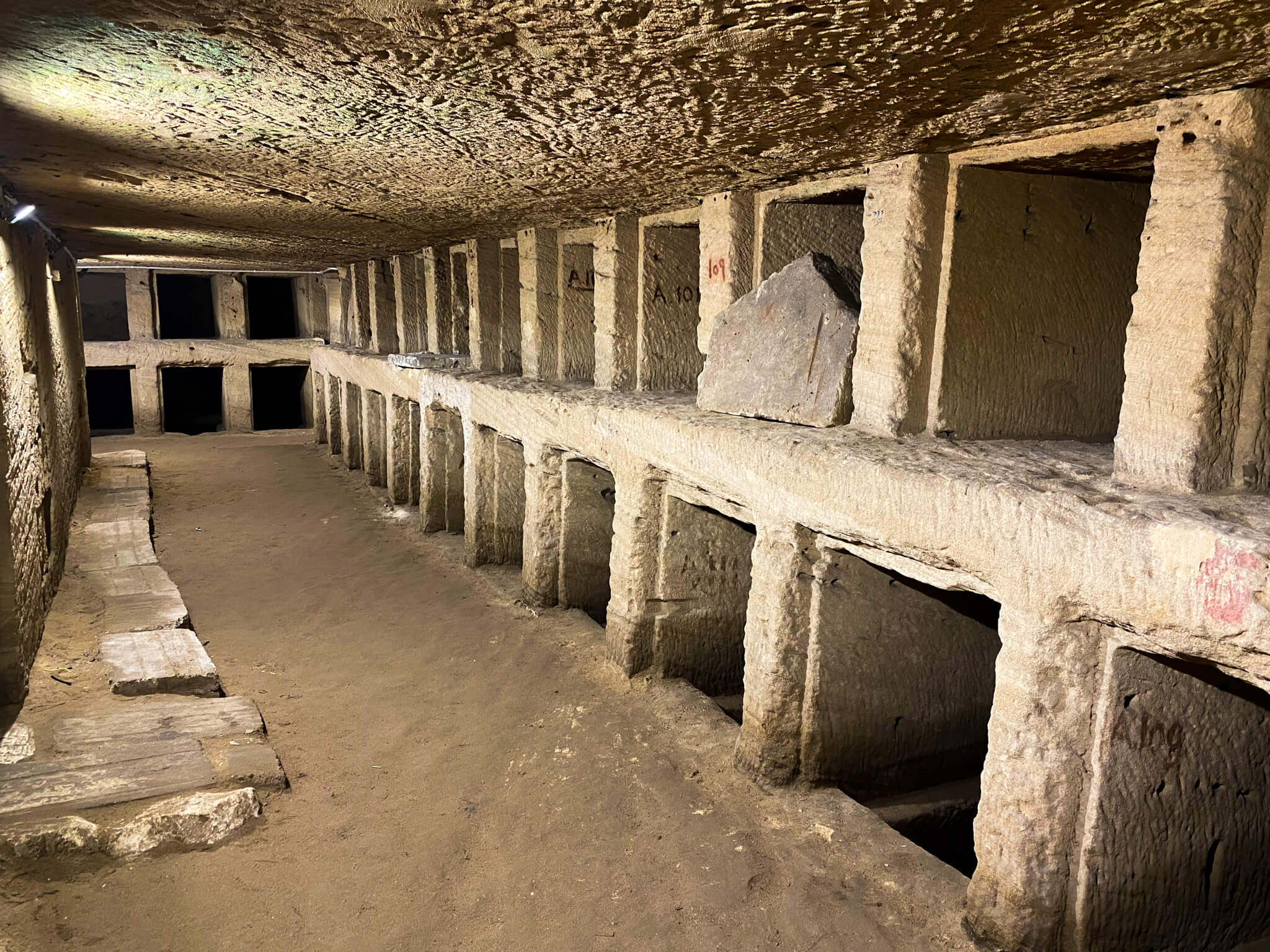
The catacombs are big enough to house a whole army of the undead.
The Roman Theatre
This ancient Roman theatre is the centrepiece of a larger archeological site, including an ancient hamman (bathhouse) and the Villa of the Birds, which contains a beautiful collection of mosaics. The theatre itself is quite small and I found the mosaics to be the most interesting thing here. However, the site is quite a nice park, so if you want somewhere to take a break away from the hustle and bustle of the city, this is a great spot. It also seems to be a popular location for Alexandrians to take wedding photos.
Entrance costs EGP 80 (€2.50/$2.60) and the location is clearly marked on Google Maps.
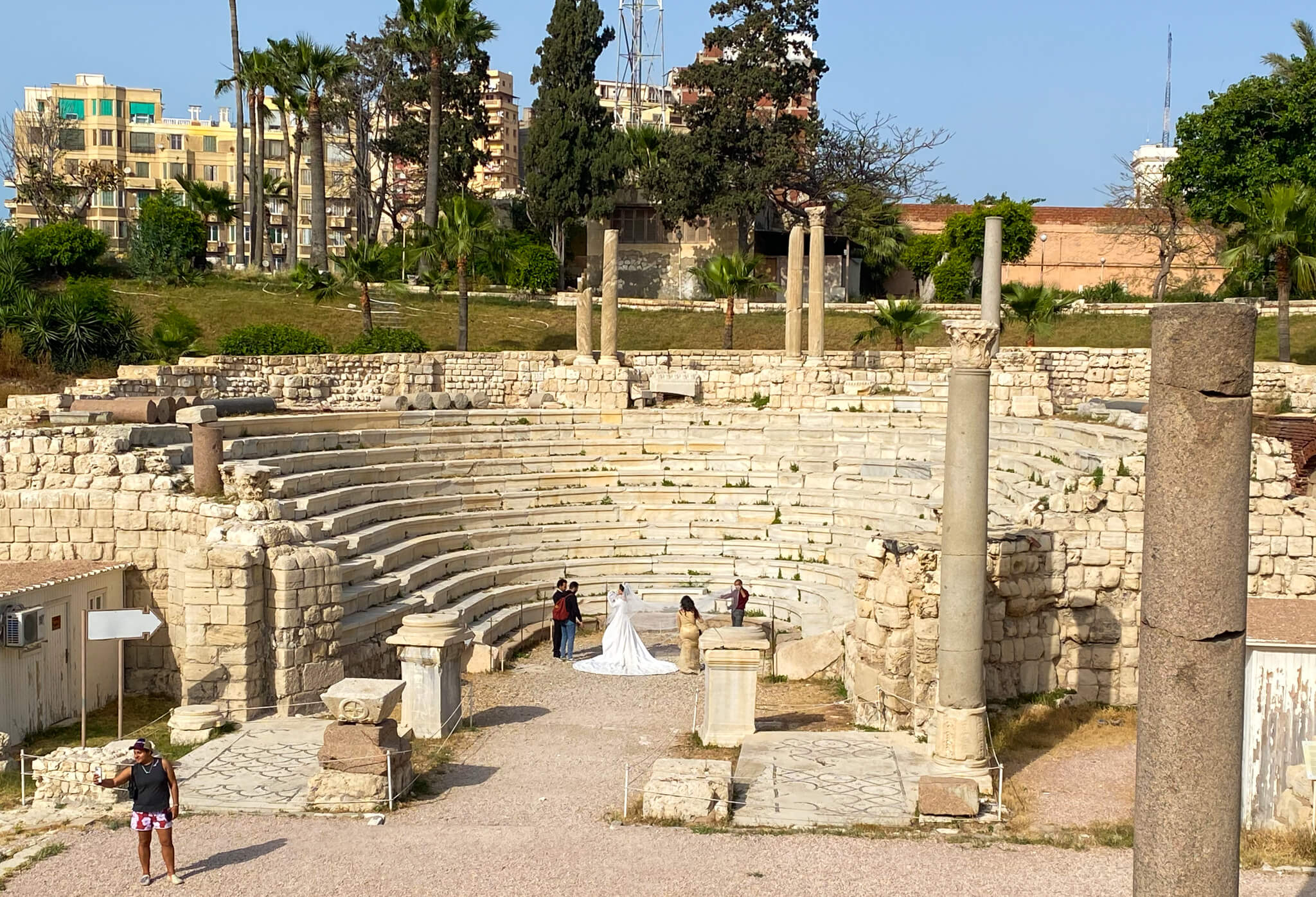
The Roman theatre is a popular location for Alexandrian couples to take wedding photos.
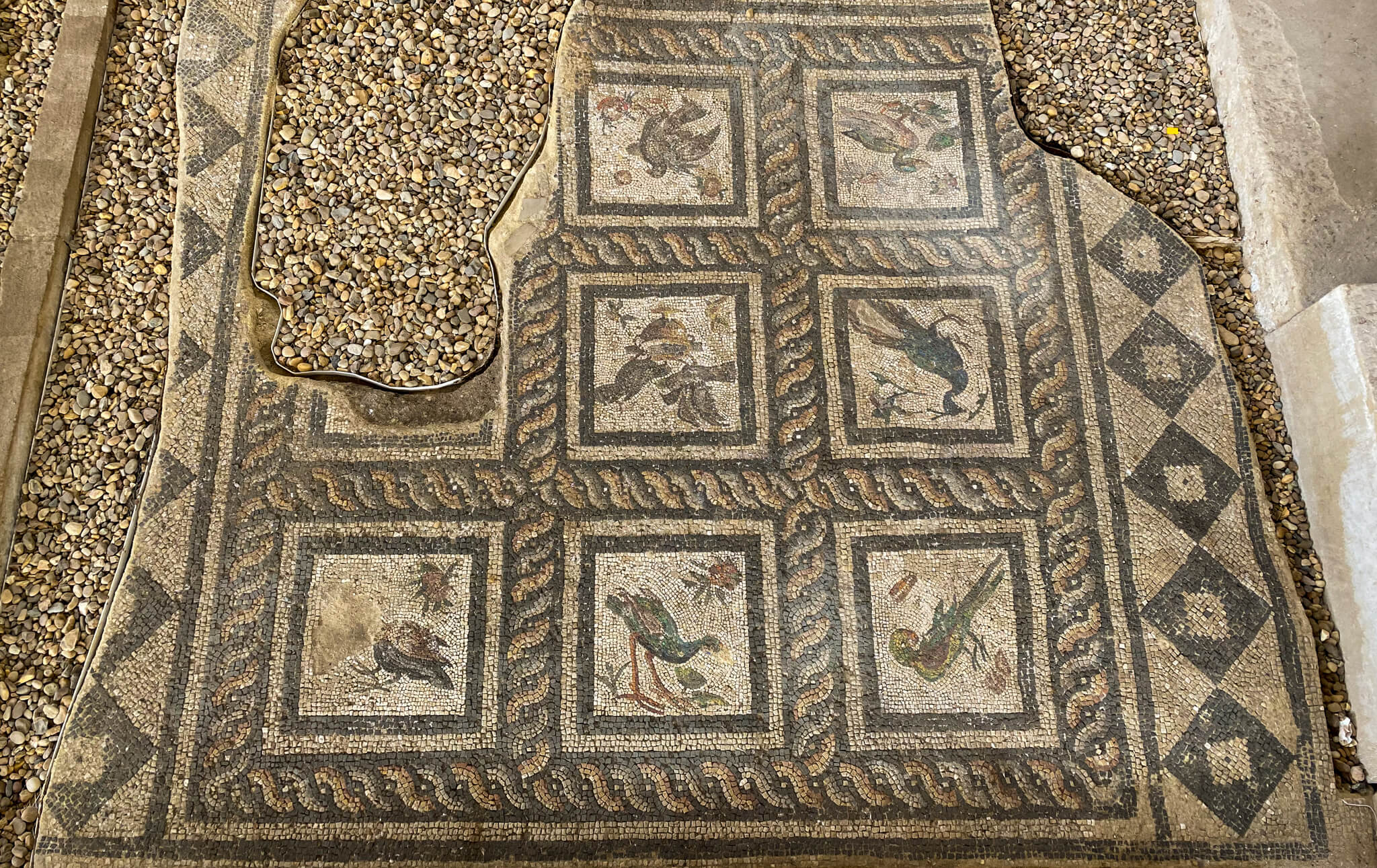
The Villa of the Birds houses several beautiful mosaics, including this one.
The Modern Library of Alexandria
The Egyptian government completed the building of the modern Library of Alexandria in 2002 as a modern library and cultural centre, commemorating the original Great Library of Alexandria, which was destroyed in the third century AD. The project was begun all the way back in 1974 and supported by UNESCO, UNDP and, critically, former Egyptian president Hosni Mubarak.
The modern library is absolutely huge, housing over 8m books, as well as rare scrolls, a planetarium and several museums. From the outside, you can see the beautiful facade covered in writings in 150 different scripts from around the world. Inside, you’re free to wander many parts of the library and admire historical items, such as the first printing press in Egypt.
The entrance price of EGP 70 (€2.17/$2.30) includes a free guided tour in English, Arabic or French, although these are not mandatory. Some museums housed inside the library, such as the museum of ancient scrolls, have separate entrance tickets. The location of the library is clearly marked on Google Maps, although the visitor’s entrance at the back of the building is not so obvious. It is located here.
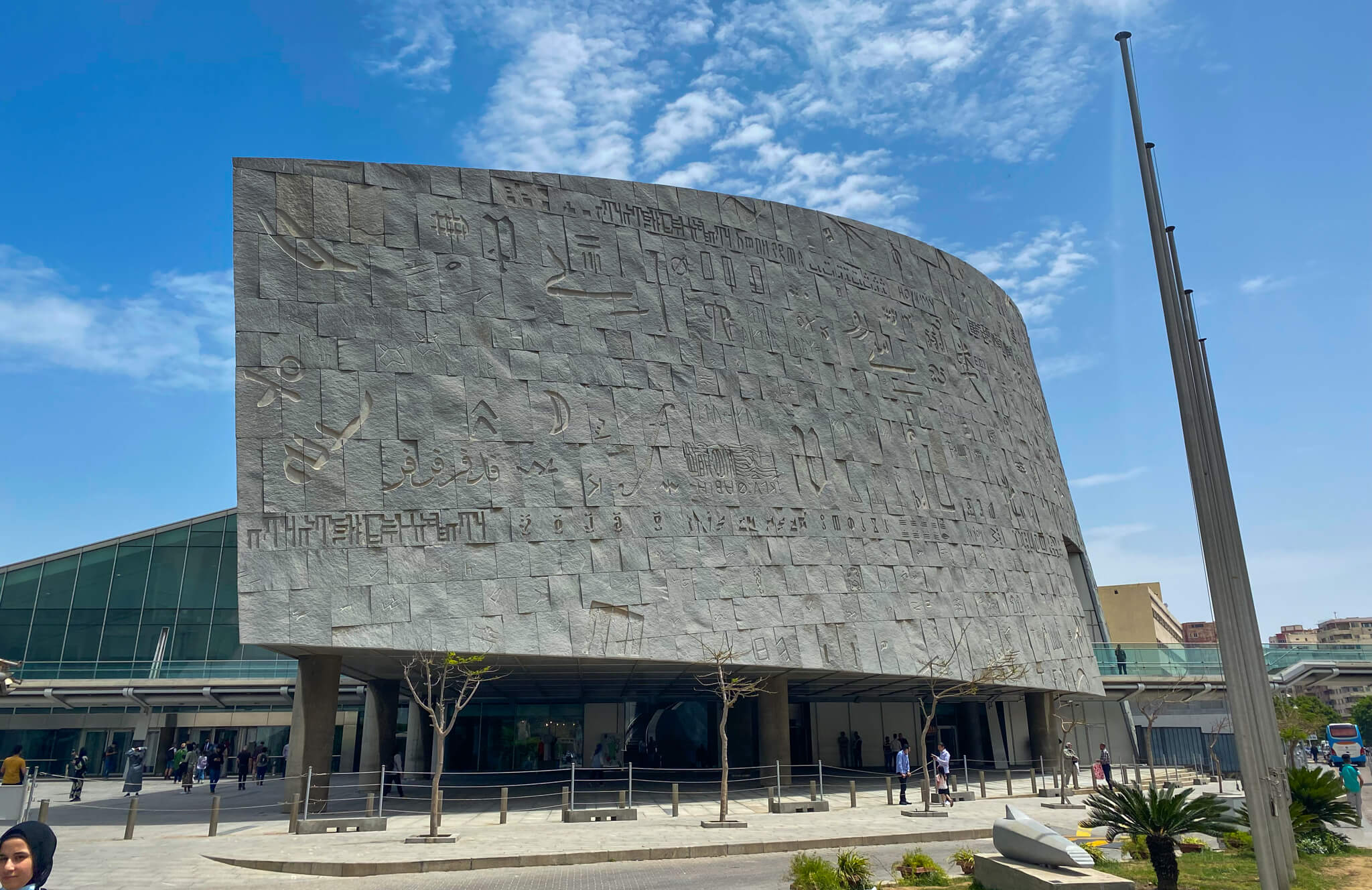
The facade of the modern Library of Alexandria contains inscriptions in 150 different scripts from around the world.
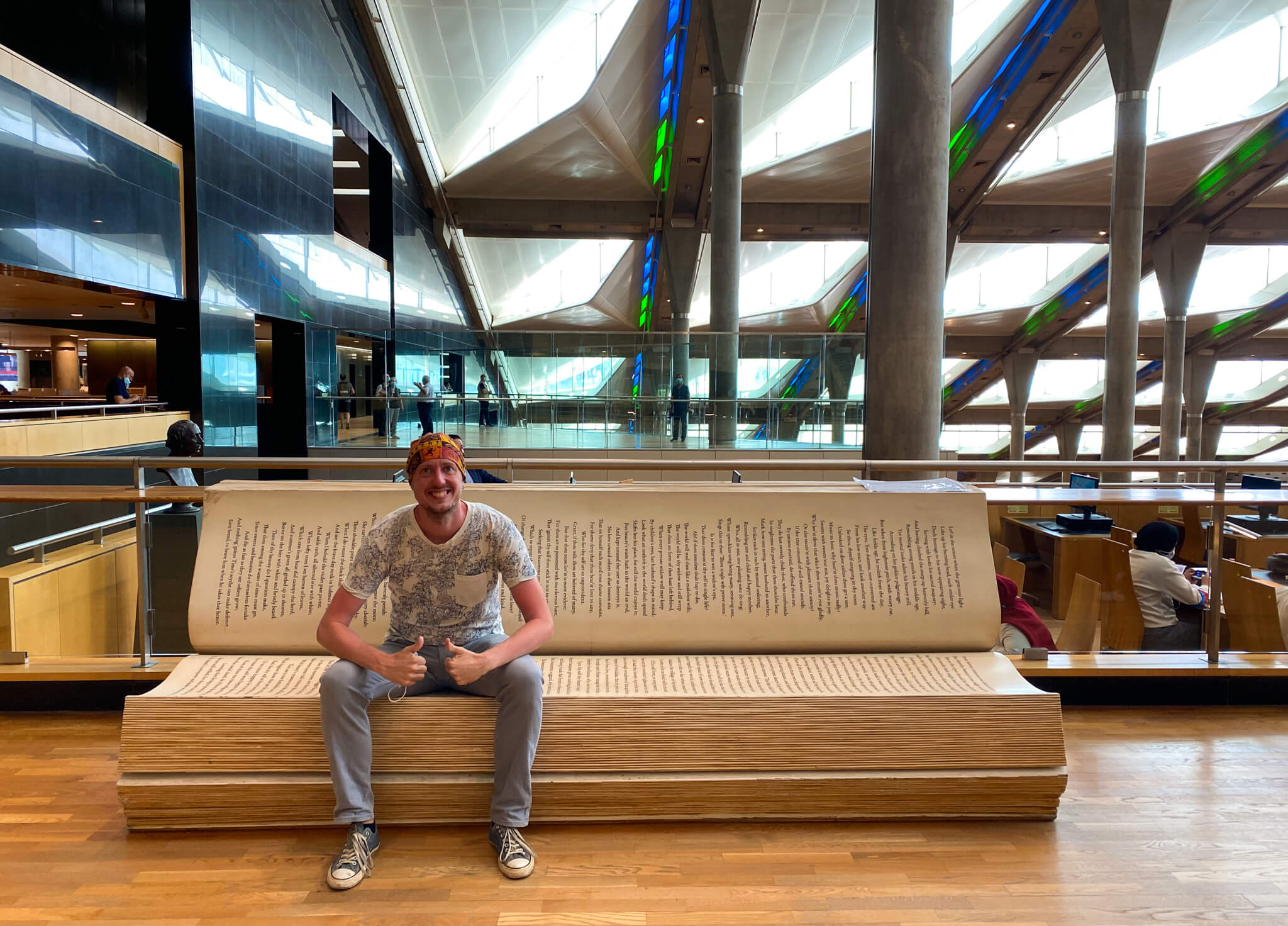
Taking a rest on Shakespeare’s bench. The text contains passages from his plays.
Alexandrian Markets
Alexandria is full of vibrant and colourful markets. They’re great places to do a bit of shopping, chat with a few locals and witness the organised chaos that is everyday Egyptian life. One particular feature of Alexandrian markets is the abundance of fresh fish and seafood. If you’re staying somewhere with cooking facilities, the markets are a great place to pick up some of the day’s catch to take back for dinner.
One of the best markets I found, completely by accident, is on Zawiet Al Aarag street, quite close to the Abu al-Abbas al-Mursi Mosque. It’s chock full of a colourful array of groceries. If you want to check it out, start from the junction here on Google Maps, and then follow Zawiet Al Aarag street until you reach the roundabout at the other end.
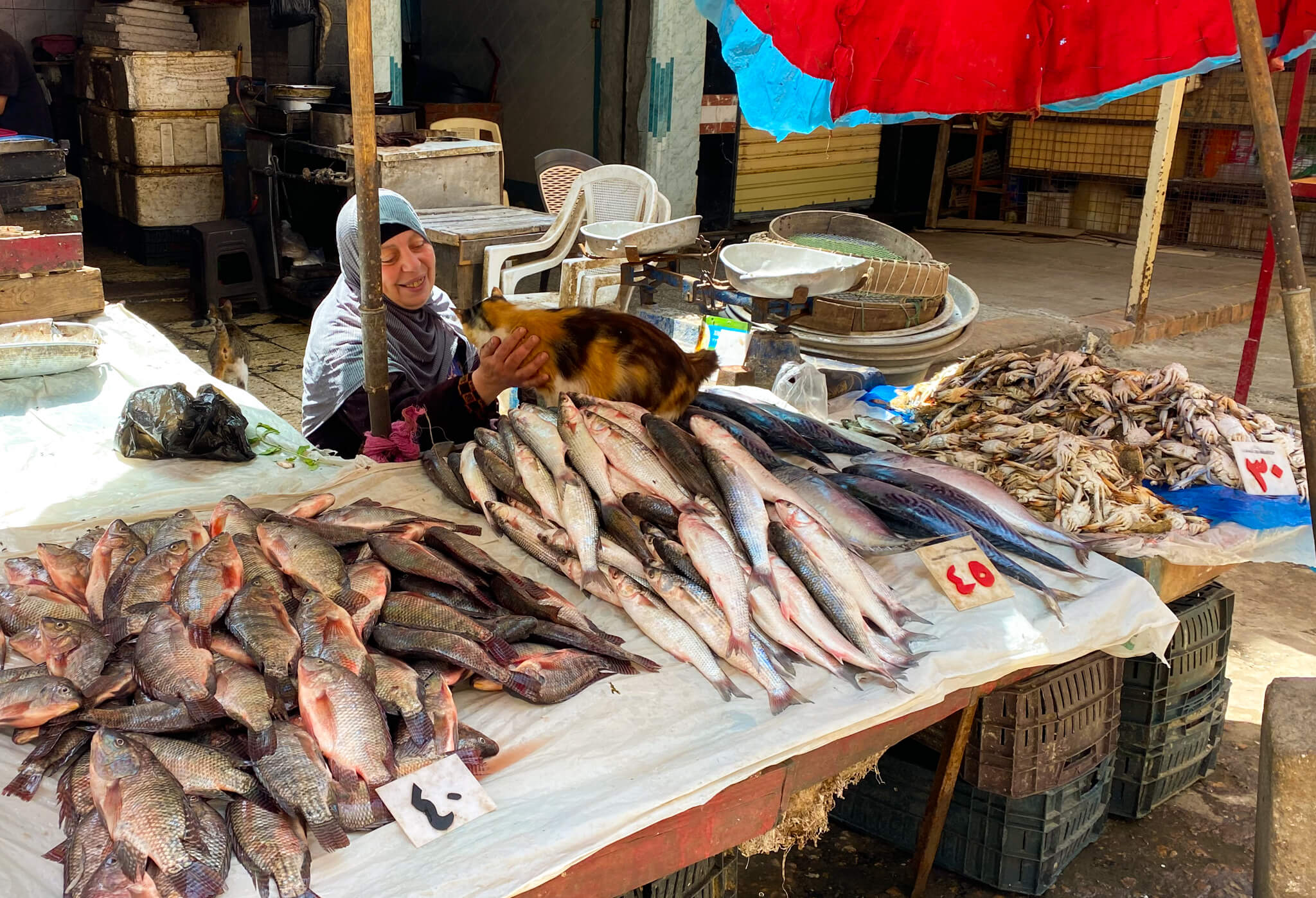
The look of adoration in the fishmonger’s eyes as she pets the cat is beautiful. I’m not sure I’d eat the fish it’s been sitting on though.
Eastern Harbour and Corniche
The weather in Egypt is lovely compared to my native Scotland, but the heat can sometimes get a bit much. One of the things I love about Alexandria is the fresh sea breeze that blows in from the Mediterranean. A relaxing stroll along the corniche is a great way to spend an hour or two, maybe with a stopoff for tea at a local cafe.
Alexandria actually has two harbours – eastern and western. The western harbour is an industrial area, so the eastern harbour, or Al Mina’ ash Sharqiyah, is where you’ll spend a lot of your time, and it’s beautiful. The corniche runs right along its length.
Directions: Follow the fresh sea air!
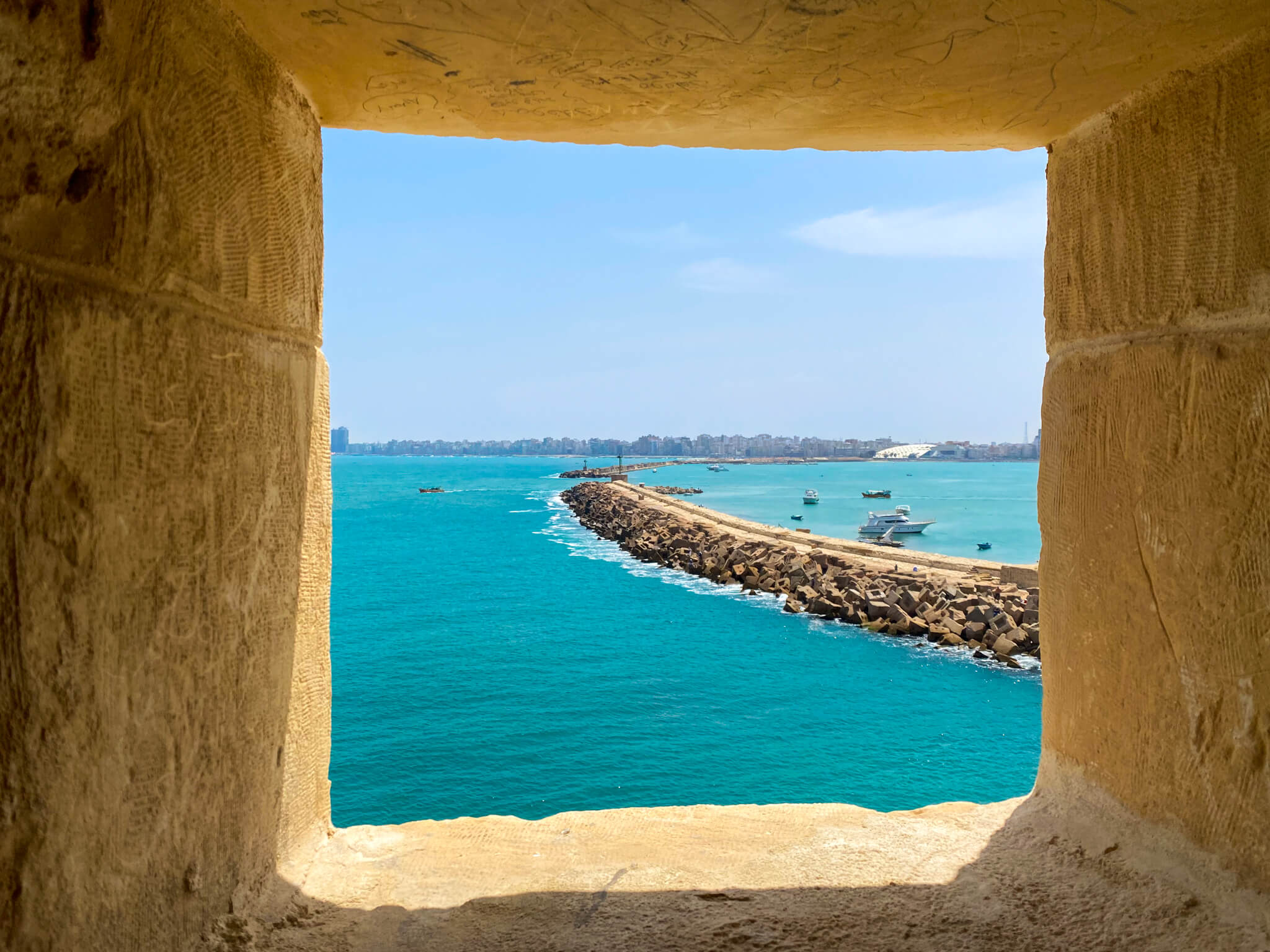
The outer wall of the Western Harbour, as seen from the windows of Qaitbay Citadel.
Suggested Itineraries in Alexandria
One of the great things about Alexandria is that it’s quite compact. Most of the historic sights are clustered within walking distance of each other not too far from the bay. Walking also has the big advantage that you get a real feel for this beautiful old city as you move between the sights.
I was a bit pushed for time during my visit, only having two nights in the city, but I managed to squeeze in everything I’d planned. However, for a more relaxed experience, I would recommend 2-3 days.
The attractions of Alexandria are roughly grouped into three areas, which means you can easily visit several together. Each of these groupings needs about half a day. Ideally, visit areas 1 and 2 on different days, as seeing all the sights takes quite some time and energy under the hot Egyptian sun.
Area 1: Western End of the Eastern Harbour – Visit Qaitbay fort at the far western end of the harbour and walk back along the corniche to the Abu al-Abbas al-Mursi Mosque. If you need a break, stop for a traditional tea or coffee at Farouk Café 1928 before exploring the local market on Zawiet Al Aarag street. You can also stop in at the Fish Market restaurant and enjoy the day’s catch with a wonderful view of the Eastern Harbour.
Area 2: Ancient Archaeological Sites – Three of Alexandria’s most interesting archeological sites are situated between the city’s two railway stations. These are the Catacombs of Kom el Shoqafa, Pompey’s Pillar and the Serapeum of Alexandria, and the Roman Theatre. Walking through these areas is also a nice opportunity to see a more local side of the city, away from the corniche.
Area 3: The modern Library of Alexandria – The library is located at the eastern end of the Eastern Harbour, far from the other sights of the city. However, don’t let this put you off, it’s a lovely stroll along the corniche from the rest of town.
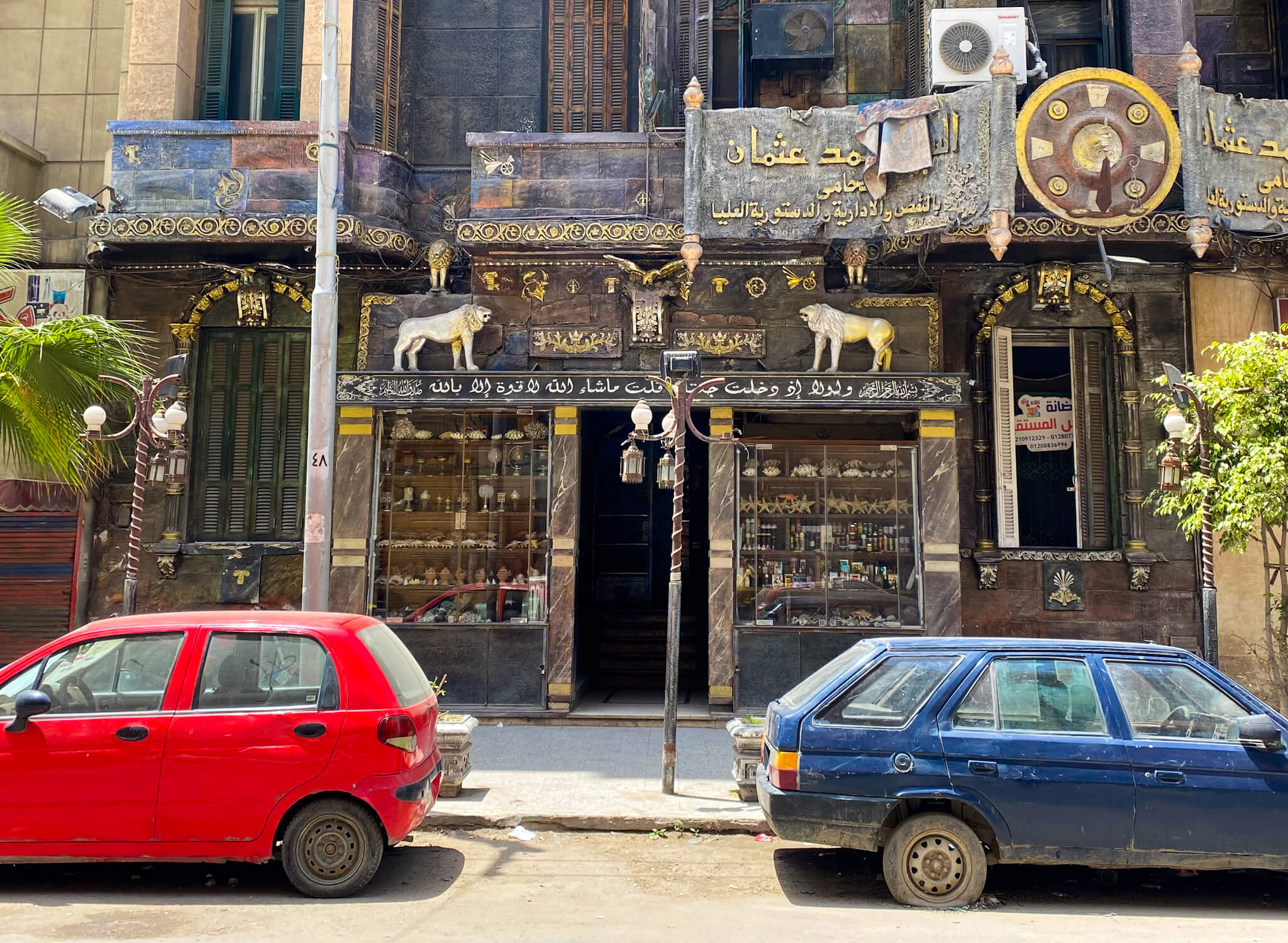
Randomly strolling the streets of Alexandria, you’ll come across all sorts of interesting sights, such as this incredible shopfront.
Places to Eat in Alexandria
There are loads of local places to eat in Alexandria, so wander around and see what takes your fancy. Even upmarket restaurants are very cheap by international standards. These are a couple of particular recommendations:
Fish Market – As its name suggests, this is a seafood restaurant inside Alexandria’s fish market on the corniche. Being on the Mediterranean coast, Alexandria is one of the best places in Egypt for fresh seafood, and Fish Market is a great example.
The day’s catch is displayed on ice on a large counter in the centre of the restaurant and you can literally just point at the particular fish or other seafood you want to eat. The waiters also speak a bit of English, which makes ordering easy. Being on the second floor, there’s a beautiful view over the Eastern Harbour to boot.
The entrance to Fish Market restaurant is located on the left side of the building that houses the actual fish market. A meal for two, including a big main, a couple of side dishes and non-alcoholic drinks cost us less than $20. It opens at noon.
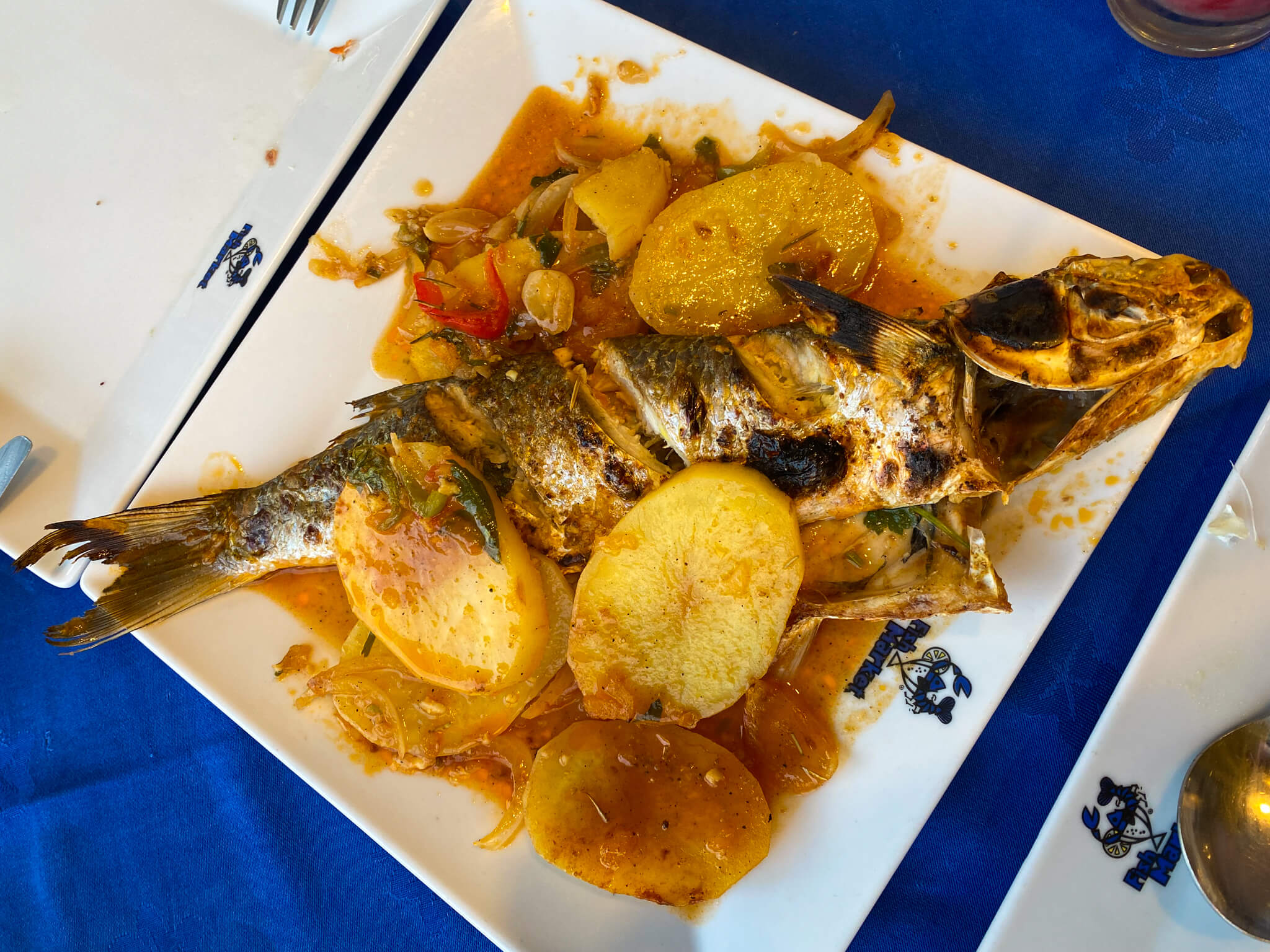
Catch of the day at Fish Market restaurant.
Awesome little breakfast place – There are many little local places to eat breakfast in Alexandria, but I mention this one because their foul (Arabic dish of fava beans) is one of the best I’ve ever had. And that’s after living in Lebanon for two years! This place is really a hole in the wall with a table and standing space out front where you can eat. Many locals come to buy breakfast and take it away with them.
There is no marker for this place on Google Maps, but the location is here. Breakfast for two, including a second helping of foul and extra bread, costs about $1.
Farouk Café 1928 – This is supposedly one of the oldest tea houses in Alexandria. The really special thing about it is they still make tea and coffee in the traditional way, by placing the pot in hot sand to heat the water. Coffee is about $0.60. The location is clearly marked on Google Maps.
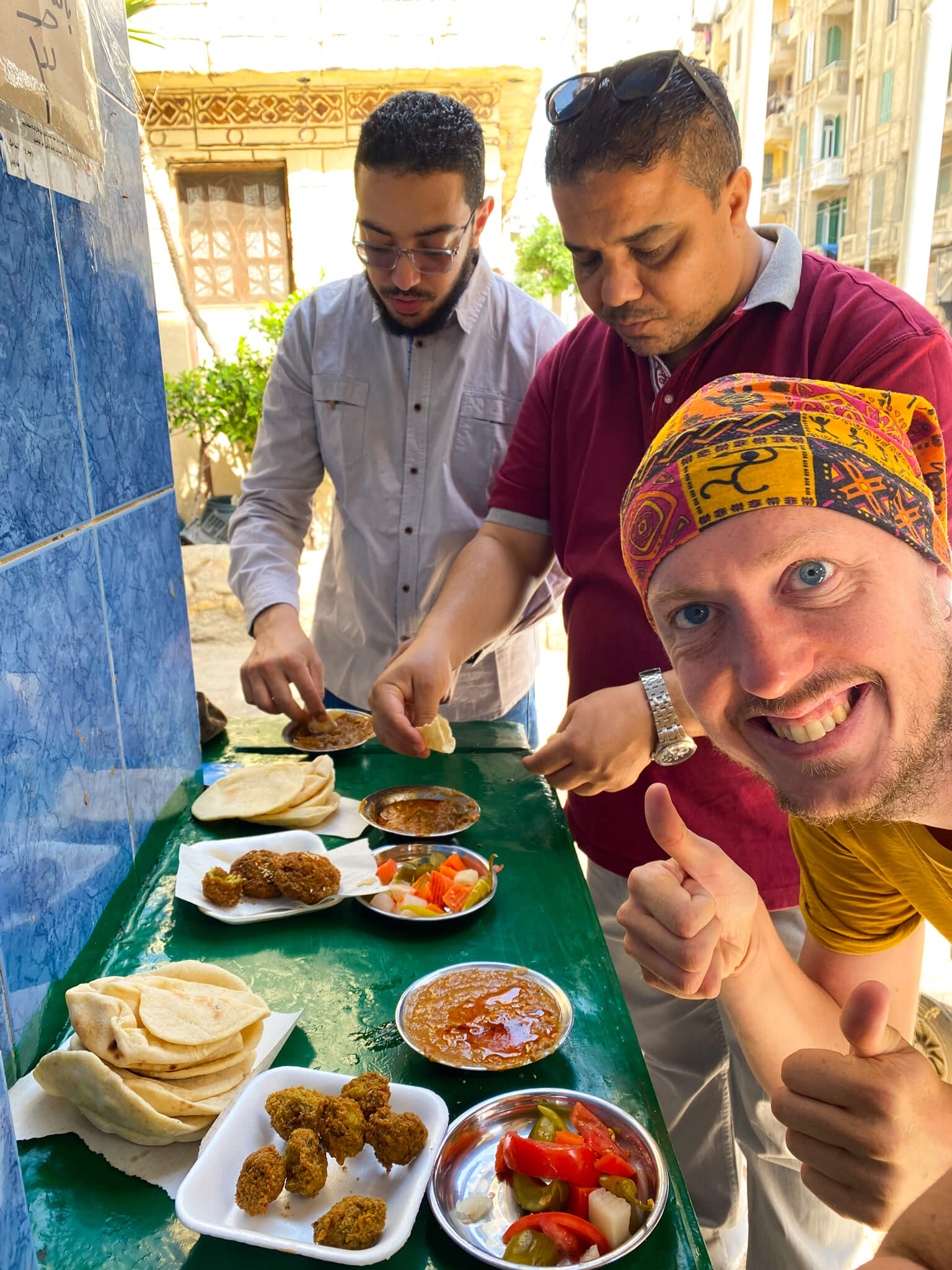
Breakfast doesn’t get more local (or delicious) than this!
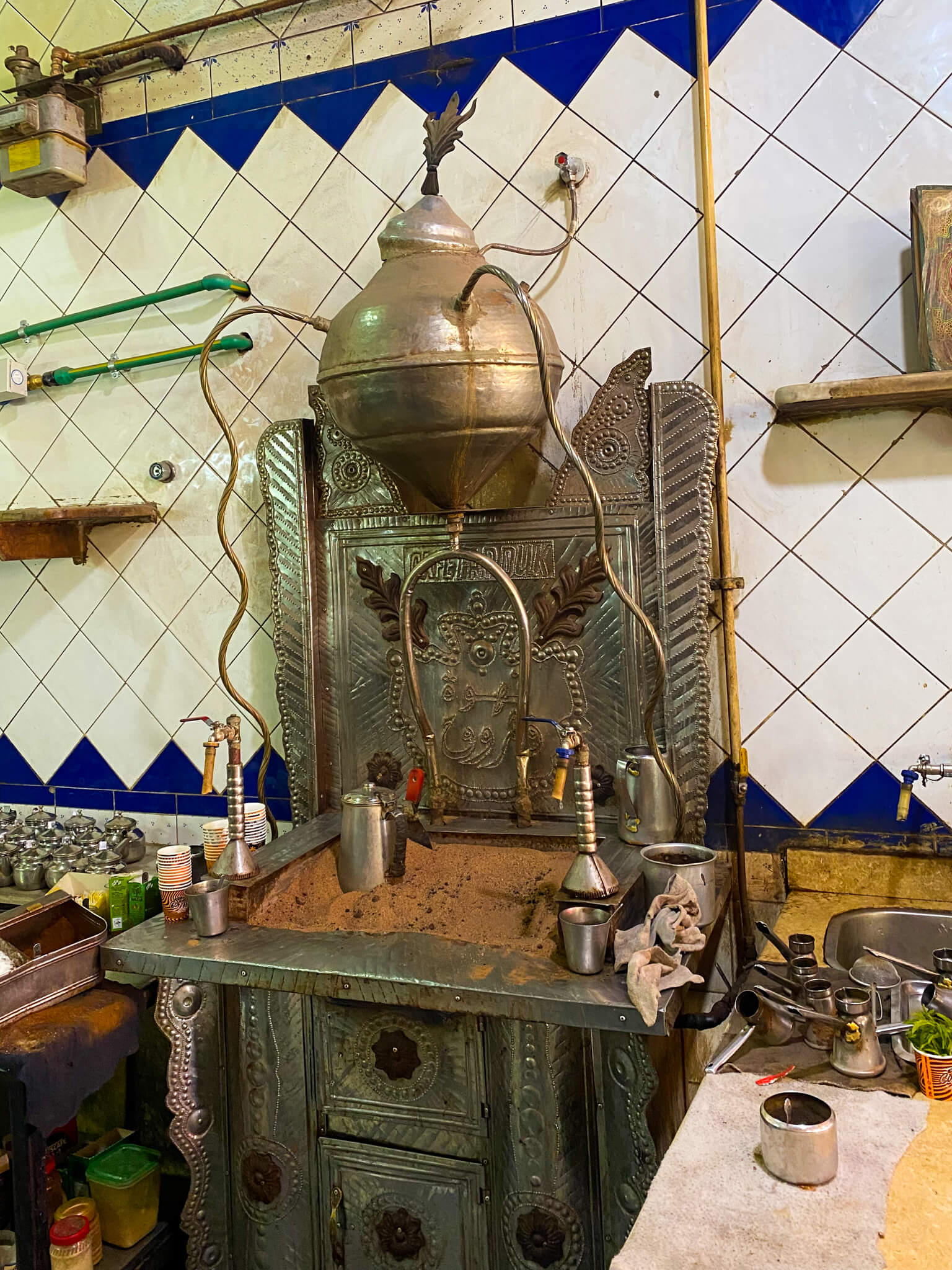
Making coffee the traditional way using hot sand at Farouk Café 1928.
Places to Stay in Alexandria
There are loads of places to stay in Alexandria. The best area is near the Eastern Harbour corniche. A quick search on any booking site will show up loads of options.
For budget travellers, the only hostel is Ithaka Hostel. If you want other options, AirBNB can be a good way of finding budget accommodation. We stayed at a hotel called Suez Hotel Canal that I haven’t found on any of the usual booking apps. It was basic, but cheap and clean, with a private bathroom and hot water. The location is here on Google Maps.
Getting Around Alexandria
The sites of Alexandria are grouped into three areas. If you enjoy walking like me, you can walk between them, but otherwise Alexandria has a range of different transport options:
Walking: This is a great way to see any city, as you’ll notice so many more things on foot than you would from a car window.
Taxi: One of the traditional yellow taxis is the easiest option if you don’t feel like a long walk. Be careful to negotiate the price before setting off, as they’re not metered.
Ride hailing apps: If you don’t feel like haggling, Uber and Careem both operate in Alexandria and are a good alternative.
Local buses: There are various local buses in Alexandria. The difficulty is knowing where they’re going. If you want to try this option, stick out a hand to stop the bus and say your destination. The driver will then tell you whether he’s going there or not. It’s generally best to check the price as well. This can be tricky depending on how much English the driver speaks, but I always managed with a bit of sign language.
One of the best places to take a local bus is for travelling along the road by the corniche. If the driver doesn’t understand you, you can always point across the harbour at your destination!
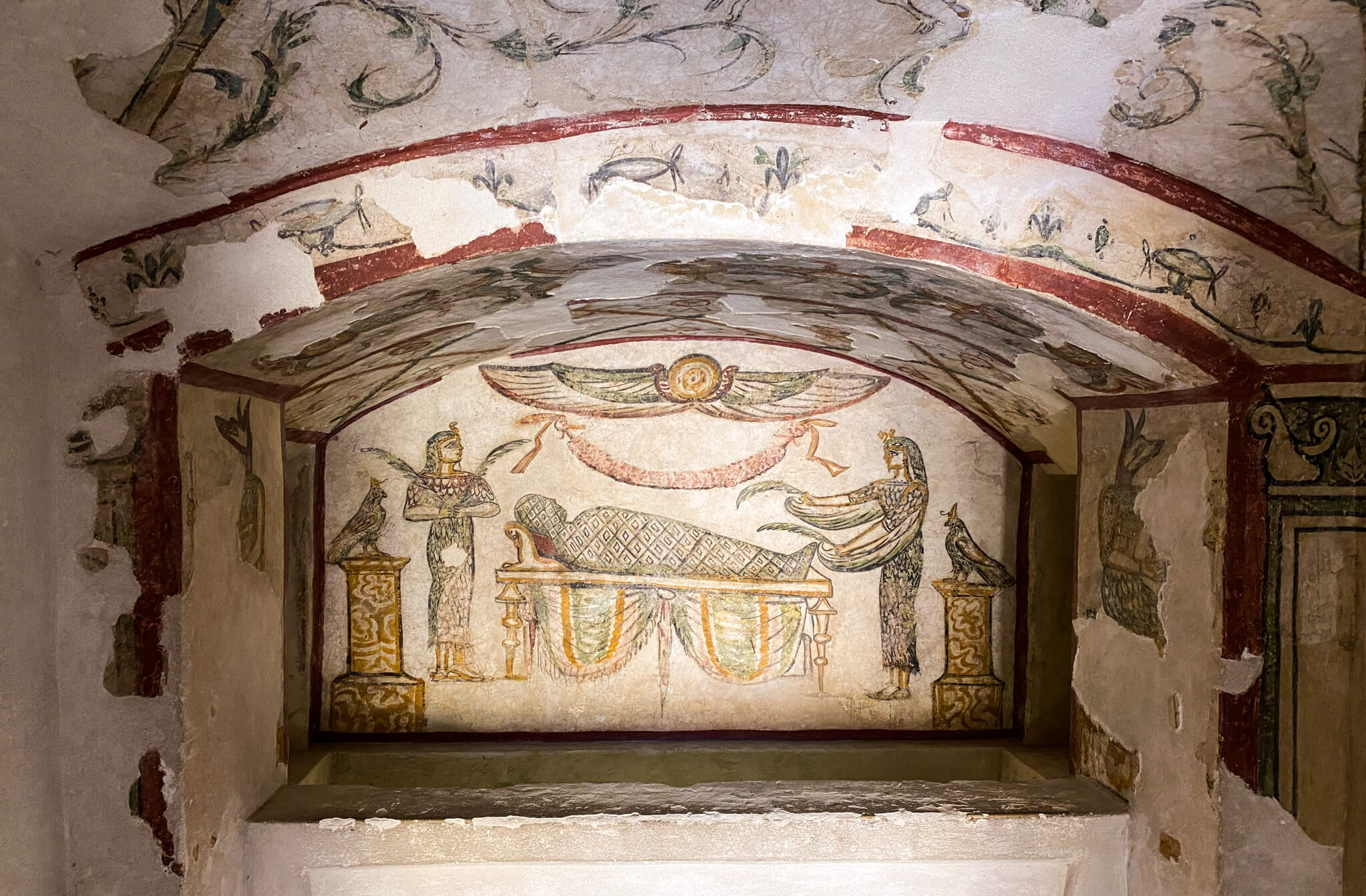
A beautiful pharaonic painting on a tomb at the Catacombs of Kom el Shoqafa.
How to get to Alexandria
There are several options for reaching Alexandria, as follows:
Train: Since January 2023, Egypt started charging foreigners in USD for train tickets and prices increased significantly. However, train is the most comfortable option. From Cairo, a second-class seat costs $15-20 and a first-class seat $20-25. The journey time is around 3.5 hours, depending on the train, but the problem is that they’re very often late. My evening train took over 6 hours and the hotel had given away my room to someone else by the time I arrived, because they didn’t think I was going to turn up (nevermind that I’d prepaid!).
Bus: Long-distance buses connect Alexandria with Cairo and other parts of the country. Buses are generally comfortable, although you will have less space than on the train. Ticket prices start at around $5.50 from Cairo, depending on the bus company. The main advantage of the buses is that they’re far more reliable than the trains.
Several companies run the route between Cairo and Alexandria, including the West and Middle Delta Bus Company and Go Bus. Both companies have ticket offices here in Cairo. In Alexandria, West and Middle Delta’s Office is here and Go Bus has an office at the main bus station. Go Bus also has a decent online booking website. The West and Middle Delta Bus Company also has buses from Alexandria to the Siwa Oasis.
Minibus: Regular informal minibuses run from beside the main train station in Alexandria to Ramses Railway Station in Cairo. They are cheap, fast and have the advantage that the departure location in Alexandria is much closer to the corniche, where you’ll likely stay, than the actual bus station. The only downside really is that some drivers drive like total maniacs.
The price between Cairo and Alexandria is about $3.50 and minibuses depart when full. As Alexandria-Cairo is a major route, there are usually plenty of passengers, so you won’t wait long. I waited 20 minutes – just time for a tea. The exact departure location in Alexandria is here on Google Maps.
Air: Alexandria is connected by air to Cairo and other cities throughout Egypt. This is the fastest way to travel, but obviously one of the more expensive options too. To be honest, the distance is so short it’s hardly worth the hassle of going through airport security.
Dangers and Annoyances in Alexandria
Egypt is generally a safe country to travel in. Many people will try to rip you off, but it’s very much against the culture to steal and violent crime is rare. That said, it’s always best to be careful and we did face one issue in Alexandria with some aggressive teenagers. This is, unfortunately, not an isolated incident in Egypt, as shown by this news article that appeared just after we left.
In our case, we were walking through a poor neighbourhood near Pompey’s Pillar on busy streets in broad daylight. We passed a group of teenage boys and I noticed them looking at us. A few seconds later, two of them started following us down the street and asking for money. We politely told them that, sorry, we would not give them money, but they were very persistent.
As English had no effect, I eventually tried telling the boys in Arabic (I know a few words), “la, shukran” – “no, thank you.” To my surprise, this provoked a very different reaction and it seemed that to them it was now personal. They started hurling abuse and swearing at us in English. We kept walking briskly while they followed us and kept swearing. Eventually, an older man on the street told them to stop. They ignored him initially, but a couple of minutes later finally gave up and stopped following us.
Unfortunately, this kind of situation happens from time-to-time in Egypt. While I don’t think we were ever in any real danger, it’s good to be prepared for how to deal with such a situation if it occurs.
The other minor issue we faced was Anna receiving a lot of stares and some of what sounded like derogatory comments while walking on the corniche one morning. After a while, she put on a headscarf and the comments stopped. Many Egyptians are very conservative, so it’s worth being aware that for women, if you feel you are receiving unwanted attention, a headscarf can be a good way to blend in.
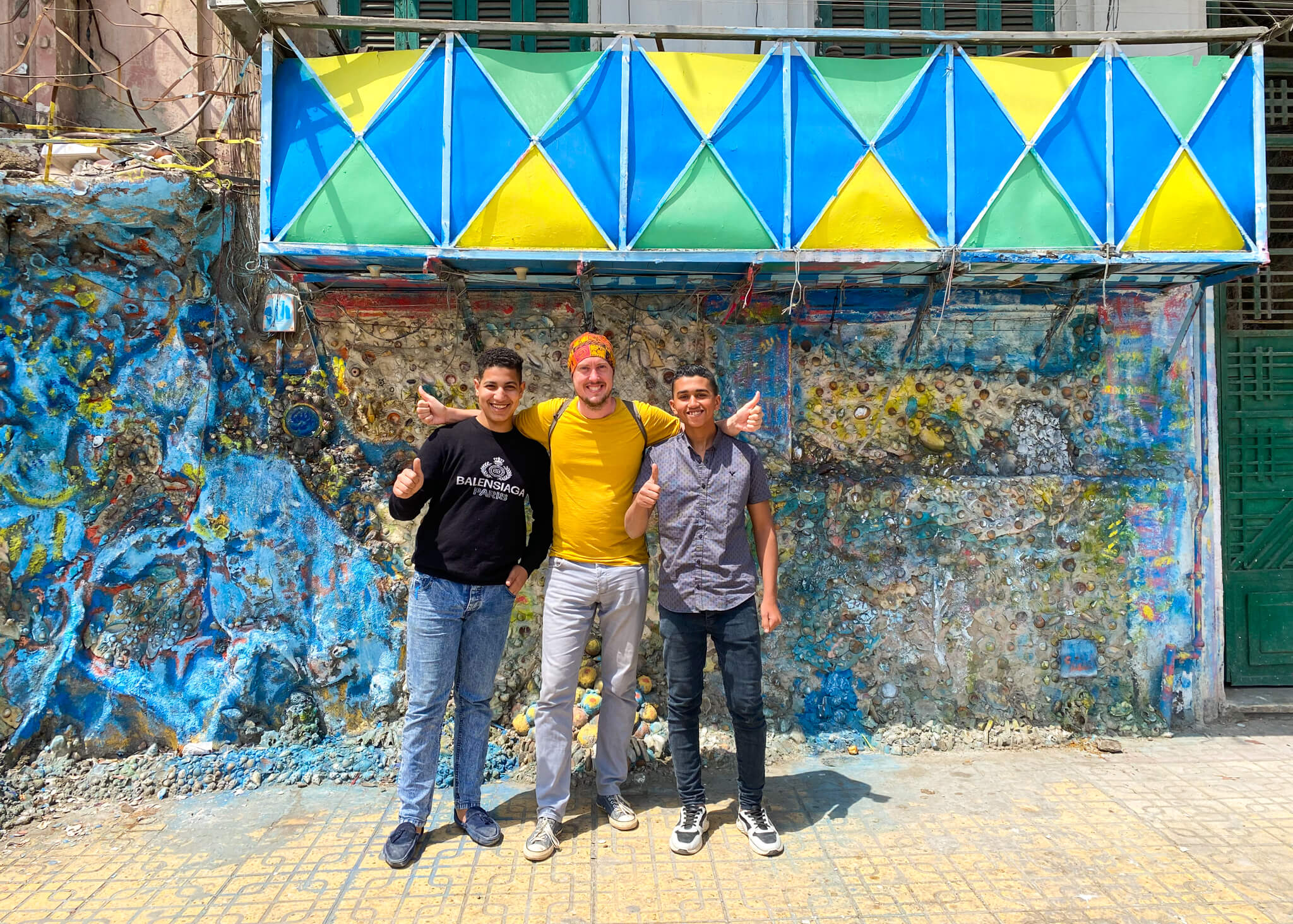
Most of the locals are extremely friendly.
More about Egypt
I’ve spent a total of about a month in Egypt on four separate trips, so I’ve seen a large part of the country. The major draw is, of course, its incredible history and amazing cultural sites, but it’s also a great place to chill out. For more travel tips and off-the-beaten track ideas, check out my other articles on Egypt:
Aswan Travel Guide: The Best Off-the-Beaten-Path Sights
Off-the-Beaten-Path Aswan Last Updated: 25 Feb 2023. Aswan is one of the most touristy cities in Egypt and for good reason. Its relaxed atmosphere, beautiful location on the Nile and the chill Elephantine Island make it the ideal place to hang out for a few days. ...
Siwa Oasis Travel Guide
Everything you need to know to enjoy travelling the Siwa Oasis, including the old town, the hot springs and delicious Egyptian cuisine.

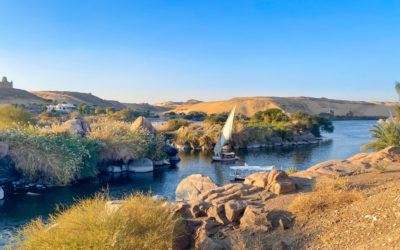
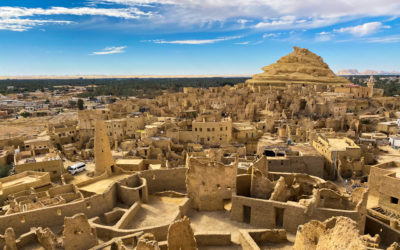
Recent Comments